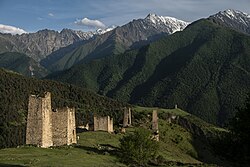Falkhan
Rural locality in Ingushetia From Wikipedia, the free encyclopedia
Rural locality in Ingushetia From Wikipedia, the free encyclopedia
Falkhan (Russian: Фалхан, Ingush: Фалхан) is a rural locality (a selo) in the Dzheyrakhsky District of Ingushetia, Russia. It is part of the Lyazhgi rural settlement.[5]
Falkhan
Фалхан | |
|---|---|
| Other transcription(s) | |
| • Ingush | Фалхане |
 Towers of Falkhan | |
| Coordinates: 42°49′16″N 44°44′07″E | |
| Country | Russia |
| Federal subject | Ingushetia |
| Elevation | 1,432 m (4,698 ft) |
| Population | |
| • Total | 0 |
| • Estimate (2021)[2] | 0 |
| • Subordinated to | Dzheyrakhsky District |
| Time zone | UTC+3 (MSK |
| Postal code(s)[4] | 386430 |
| OKTMO ID | 26620430121 |
Founded in the c. 16–17th centuries, Falkhan was considered one of the historical cradles of Ingush people. The village consisted of Ingush towers: 3 battle towers, a semi-combat tower and 12 residential towers. All the towers are 5-storey with flat roofs and high parapets. The towers aroused deep scientific interest among researchers and they were studied by prominent Russian and Soviet archaeologists.
The toponym is of ancient origin. It splits into three parts: Falkha-n-e, out of which, "-n" and "-e/ye" are suffixes of Ingush language.[6] Ethnonym Falkhankhoy (a teip) takes its name from Falkhan.[7] According to Akhmad Suleymanov, the name of the village is associated with the Ingush word fala (фала) which means "free".[8]
Falkhan is located in the Kistin Gorge, on the slope of the spurs of Mount Mat-Loam (Table Mountain).[9] It's south of village of Metskhal and southwest of village of Khast-Mokie. There are nearby several pastures and meadows like Tielta, Velkh tsona, Dal-tsonashkie, Mekhanchie and others. In addition, there are old places of worship like Myat Selash, Ashp Koag, Gerg-Argie and Motskharashkie.[10]
Together with the villages of Targim, Egikal, Khamkhi and Metskhal, Falkhan is considered one of the historical cradle of the Ingush people.[11][12] According to ethnographer Bashir Dalgat, all of the villages and settlements (more than 20) of the Fyappin Society originate from Falkhan.[13] The population village was mainly made up of the Dzarakhovs, but also Adzhievs, Bersanovs, Umarovs and Kotievs.[14]
According to a legend, the village was founded by Ferkhast and his three sons who left village of Tyarsh. The territory of the village belonged to the Ghamnäqhan tribe (Ingush: ГIамнаькъан) which made it hard for others to settle here.[15] According to the same legend, the Ghamnäqhan were later killed by the inhabitants of Falkhan.[16][15]
The village consisted of Ingush towers which possibly date back to the 16th-17th centuries: 3 battle towers, a semi-combat tower and 12 residential towers. All the towers are 5-storey with flat roofs and high parapets. Throughout history, the towers were studied by archeologists like Leonid Semyonov, Ivan Shcheblykin, Evgeny Krupnov, Aleksey Robakidze, Vladimir Markovin, Jabrail Chakhkiev.[17] The inhabitants were engaged in the manufacture of products from horn, clay, bone, wood and archery weapons. Cloth making, deposits of sulfur and saltpeter were developed, there were ores of copper and sulfur pyrites, brown iron ore, lead and zinc, as well as ocher.[18]
In 1811–1812, there were 30 households in Falkhan.[19][14] By the 1830s, the majority of Falkhan's inhabitants migrated to the villages of Dzheyrakh-Yurt, Sholkhi, Ghalghai Yurt and Fortress of Vladikavkaz, located in plain Ingushetia.[20] By the middle of 19th century, Dzarakhovs and Kotievs of Falkhan migrated to the village of Angusht. During that time, a mosque and a madrassa was built opposite of the Solar Necropolis of Falkhan with the help of Andi theologian Murdal-Hajji. Dibr-Mulla worked as the imam of the mosque at the request of Murdal-Hajji.[18] In 1886, there were 22 families living in Falkhan: 10 Dzarakhov families, 3 Kotiev families, 3 Bersanov families and 2 Adzhiev families.[14]
In 23 February 1944 the inhabitants of Falkhan were deported during the deportation of the Chechens and Ingush to Kazakh SSR and Kirghiz SSR. The natives who returned from returning from deportation in 1957 were denied the right to settle back in the village. The towers and crypts of the village of Falkhan were repeatedly explored in the 1930s and 1970s, and their results were presented in various scientific publications.[18]
Today, the village with its historical sites is included in the Dzheyrakh-Assa Museum-Reserve, founded in 1988. The archaeological monuments of mountainous Ingushetia, including the village of Falkhan, arouse deep scientific interest among researchers.[18]
| Year | Pop. | ±% |
|---|---|---|
| 1874 | 71 | — |
| 1883 | 143 | +101.4% |
| 1890 | 115 | −19.6% |
| 1914 | 87 | −24.3% |
| 1929 | 20 | −77.0% |
Source:
| ||
Seamless Wikipedia browsing. On steroids.
Every time you click a link to Wikipedia, Wiktionary or Wikiquote in your browser's search results, it will show the modern Wikiwand interface.
Wikiwand extension is a five stars, simple, with minimum permission required to keep your browsing private, safe and transparent.